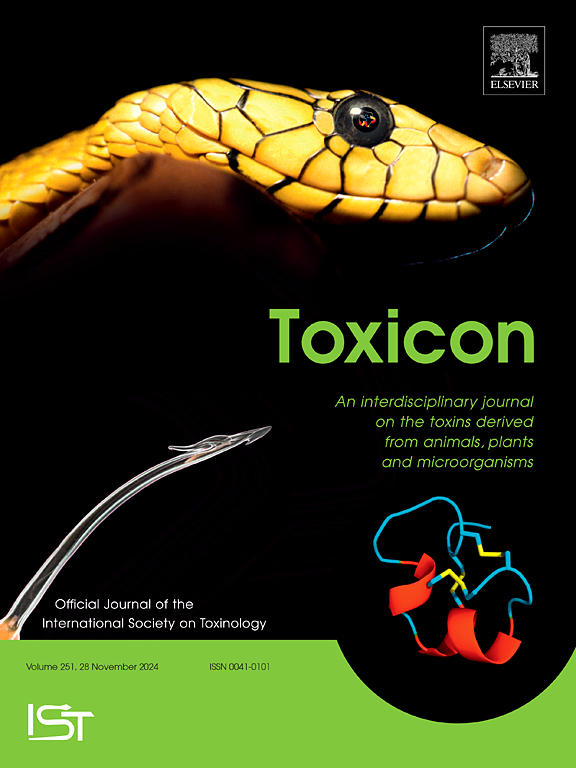A decade of toxicity research on sea urchins: A review
IF 2.6
4区 医学
Q2 PHARMACOLOGY & PHARMACY
引用次数: 0
Abstract
Sea urchins have been used extensively in toxicity studies worldwide. In this review, toxicity studies that used sea urchins as the organism of choice during the last decade (from 2014 to 2023) were assessed. The selected articles were analysed for the following main points: (i) the world regions where sea urchins are predominantly utilized in toxicological studies, (ii) the sea urchin species most frequently employed, (iii) the most frequently used toxicological assays, and (iv) the chemical under examination. The results indicate that the scientists in Europe most often decide to work with this organism. Specifically, sea urchins were sampled from the Tyrrhenian Sea and the Atlantic coast of Spain and Portugal for the toxicity studies. The most frequently selected species of sea urchin is Paracentrotus lividus, followed by Arbacia lixula and Strongylocentrotus purpuratus. Furthermore, the toxicity experimental method that is most often applied is the embryotoxicity that includes a version of the sea urchin embryo-larval development test endpoints. Currently metals are the most frequently researched pollutant of this species as target organism, followed by environmental samples (e.g. sediment or wastewaters), plastics and nanoparticles (metal and metal oxide nanoparticles, silicate nanoparticles, polystyrene nanoparticles and carbon nanotubes). At the end, the obtained results were discussed and recommendations for further work with sea urchins in toxicological studies were proposed.
海胆毒性研究的十年回顾。
海胆在世界范围内被广泛用于毒性研究。在这篇综述中,评估了过去十年(2014年至2023年)以海胆为首选生物的毒性研究。对选定的文章进行了以下主要分析:(i)主要利用海胆进行毒理学研究的世界区域,(ii)最常使用的海胆种类,(iii)最常用的毒理学分析,以及(iv)所检查的化学品。结果表明,欧洲的科学家最常决定研究这种生物。具体来说,研究人员从西班牙和葡萄牙的第勒尼安海和大西洋沿岸采集海胆样本进行毒性研究。最常被选择的海胆种类是lividus,其次是Arbacia lixula和strongylocentrrotus purpuratus。此外,最常用的毒性实验方法是胚胎毒性,其中包括海胆胚胎-幼虫发育测试终点的一个版本。目前研究最多的污染物是金属,其次是环境样品(如沉积物或废水)、塑料和纳米颗粒(金属和金属氧化物纳米颗粒、硅酸盐纳米颗粒、聚苯乙烯纳米颗粒和碳纳米管)。最后,对所得结果进行了讨论,并对进一步开展海胆毒理学研究提出了建议。
本文章由计算机程序翻译,如有差异,请以英文原文为准。
求助全文
约1分钟内获得全文
求助全文
来源期刊

Toxicon
医学-毒理学
CiteScore
4.80
自引率
10.70%
发文量
358
审稿时长
68 days
期刊介绍:
Toxicon has an open access mirror Toxicon: X, sharing the same aims and scope, editorial team, submission system and rigorous peer review. An introductory offer Toxicon: X - full waiver of the Open Access fee.
Toxicon''s "aims and scope" are to publish:
-articles containing the results of original research on problems related to toxins derived from animals, plants and microorganisms
-papers on novel findings related to the chemical, pharmacological, toxicological, and immunological properties of natural toxins
-molecular biological studies of toxins and other genes from poisonous and venomous organisms that advance understanding of the role or function of toxins
-clinical observations on poisoning and envenoming where a new therapeutic principle has been proposed or a decidedly superior clinical result has been obtained.
-material on the use of toxins as tools in studying biological processes and material on subjects related to venom and antivenom problems.
-articles on the translational application of toxins, for example as drugs and insecticides
-epidemiological studies on envenoming or poisoning, so long as they highlight a previously unrecognised medical problem or provide insight into the prevention or medical treatment of envenoming or poisoning. Retrospective surveys of hospital records, especially those lacking species identification, will not be considered for publication. Properly designed prospective community-based surveys are strongly encouraged.
-articles describing well-known activities of venoms, such as antibacterial, anticancer, and analgesic activities of arachnid venoms, without any attempt to define the mechanism of action or purify the active component, will not be considered for publication in Toxicon.
-review articles on problems related to toxinology.
To encourage the exchange of ideas, sections of the journal may be devoted to Short Communications, Letters to the Editor and activities of the affiliated societies.
 求助内容:
求助内容: 应助结果提醒方式:
应助结果提醒方式:


